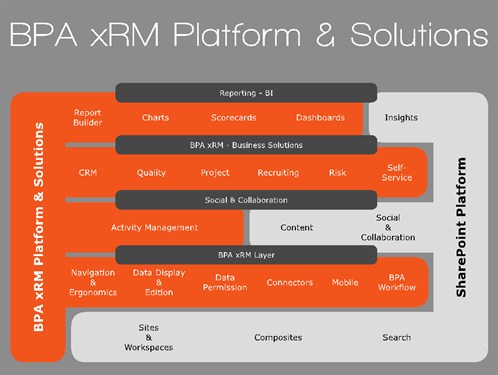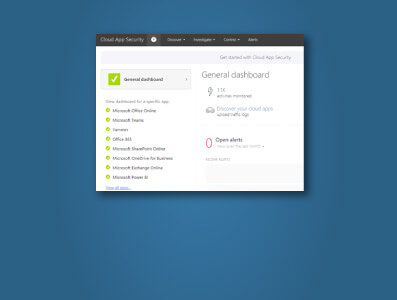This is an interesting Blog written by Rüdiger Gros
CEO EFEXCON AG. BPA Solutions are Sliver Exhibitors at the
European SharePoint Conference 2011 in Berlin 17th-20th October.
INTRODUCTION
SharePoint is an excellent software platform to bring
flexibility to endusers. And it is a great software development
platform to create state oft he art applications, even though there
are still few people out there that really grabbed the
potential.
As SharePoint delivers very limited capabilities to build
flexible business applications with SharePoint standard
functionality, the creation of business application with SharePoint
is handed over to developers – with all heavily discussed
advantages and disadvantages of custom development.
FOCUS OF THAT ARTICLE
The focus of this article is neither the discussion of
good and bad things in manager goals and decisions in software
strategies nor a discussion about enduser dreams about custom
developed software vs. standard software (perhaps I will do that at
another time..).
This article shows an alternative approach to deliver what
managers AND endusers want to achieve:
BPA XRM – BUSINESSING SHAREPOINT
BPA Software delivers a Software-Configuration-Framework
(BPA xRM) based on SharePoint, that enhances SharePoint by a slim,
but very effective configuration layer. This frameworks enables the
configuration of complete business applications without programming
– and without modifying anything that SharePoint delivers

BPA xRM Platform & Solutions
robust Power for IT and Business
This article will not dive into the depth of the framework, but
it will show the philosophie and power behind that concept:
- BPA Solutions delivers ready to go standard business
templates, that deliver a fully competitive functionality
out of the box. You can have CRM, PM, QM, Recruiting Applications
as true standard software (BPA Solutions) based on true Standard
software (SharePoint), that is ready to run locally or hosted. - BPA applications are NOT created by
programming. They are completely configured based on the
BPA xRM framework. So anybody that is able to configure the
framework, can modify anything he wants. And of course create
anything he wants in addition. - Configuration is simple
enough to enable trained endusers
to create their own business applications or extensions to business
applications (if they are allowed by it-policies). - SharePoint behind the scenes delivers the lists and
libraries. BPA xRM delivers the layer to connect and
relate the objects to build business applications based on any
objects that SharePoint provides. - BPA xRM adds a metalayer, that allows to
create master- and multi-Detailforms, cascading dependencies,
context aware dataentry forms, a very granular permission model and
a lot more, which is missing in the SharePoint basics. - BPA xRM is not only “some additional
webparts”, even though it uses of course webparts as
budilding blocks. It is a managed application environment,
that evolves by software maintenance without suffering from user
configurations, because configuration and data are below the
maintenance level, that will be updated by improved versions of BPA
xRM
As the framework ist used worldwide at a lot of well known
customers, it can be said, that it has proven it’s abilities since
almost 10 years now and can be said to be mature.
Perfect IT to business alignment
Based on these few building blocks, the concept enables the
creation of astonishing, impressing und VERY useful business
applications, that really reflect the daily truth in the
business.
So, why is this concept the key to impressive it to business
alignment – and the key to get SharePoint ROI at lightning
speed?
- The templates have already proven there quality at a lot of
customers and deliver a true quickstart without any modification
asap - This concept enables business experts to design and modify all
there business needs without having it engineers on board – because
there is no it-engineering necessary! - Modifications or Additions are made in minutes to hours
instead of weeks and month. - Configuring the framework changes nothing in the building
bricks of IT – so there is no need for technical tests, deployments
or integration work for newly build code - The IT can fully concentrate on providing a robust SharePoint
platform and a robust security policies and SharePoint Platform
sizing based on NON-functional requirements oft he business - IT is not bound to understand functional business needs in
detail to transform the requirements into IT-requirements - If it comes to IT-integration topics, everything is done on the
SharePoint-Level, so it is perfectly positioned in the
IT-sector - Once the technical challenges to integrate other solutions via
external content types or other ways to integrate business data are
finished, the ball is passed back tot he business - business can use the new data objects for modelling their
scenarios like before with other SharePoint internal objects –
because after IT has embedded the new external content types, these
objects work like internal lists and libraries from BPA framework
perspective
a revolutionary change of the “development” approach
This approach changes not only the roles of involved people, it
opens new ways to support your business needs, because you can just
model your minor business changes in minutes or hours instead of
weeks and month.
The classic approach
When introducing new business apps, like a CRM system, the
typical approach is the collection of all current, future and might
be requirements to not forget anything, that migt eventually come
up later – because people are afraid
- that they run into a dead end with their solution
- that development and change cost will ruin there ROI, if
they come up with bigger changes in a later phase - that future requirements after the initial project will not be
budgetet, if not addressed from beginning on
This approach leads to huge projects, oversized applications,
uncomfortable user navigation and of course outdated application
processes from the beginning on – because the business is changing
and evolving all the time (I hope yours, too!)
The BPA xRM approach: Think -configure – use
With the BPA xRM framework, you do not have to know in advance
what will be in 6 month, 1 year or even later. You can start with
the template and if you find out, that something is missing, you
can just add that.If you find something annoying, just change
it.
There is no programming, integration, technical testing, because
every object that shall be used and related to any object already
there in the robust SharePoint base.
This concept enables you to prototype your desired enhancement
or change and if you like it, you can use it. If you don’ t, just
change some entries in the configuration.
As it only takes some minutes to some hours to create new
business scenearios or features, the volume to take care of
is typically very small and the benfit of not having to develop
anything is of course, that you can avoid a lot of technical
work.
Critical voices – and true answers
When starting BPA xRM projects, we are typically asked, if we do
not need a global corporate application requirements document to
understand all interactions. And how we think to manage, that this
“just go for it” approach shall lead to integrated concepts?
The truth is: If those spec documents are available,
this is a good help to understand the management goals.
But in these documents is not the reality oft he business people. I
do not know any spec that is not re-discussed after our first
questions when modelling the business.
We just go on, discuss with people, show how it could be and
finalize a productive prototype. After some days,
weeks or whatever time has passed, weh ad several iterative
improvements and it is not rare, that after 6
month, we have a datamodel and configuration model, which looks a
bit “unmanaged”.
But who cares? We throw that model away,
because now we have learned together with the customer, what the
true core business is, that we should model. And we rebuild
it properly in a few hours to a few days.
This approach leads to lightning speed software
introductions with a closeness to business, that
can almost not be topped. Minor changes are typcially made
by business itself, because it is so easy. For major changes, we
discuss about processes and the customer decides, if he wants to
model himself or if his service provider shall do.
Authors profile:
Rüdiger Gros, CEO EFEXCON AG, www.efexcon.com
I am in the IT and Software-Development business since 1989 and
my role has passed all steps from softwaredevelopement over
it-integration up to business consulting. With deep knowledge in
ERP, DMS and BI-Systems, I started to use SharePoint from 2001.
With more than 350 successful lead projects, people rate me as
professional project manager and I have been awarded several times
for innovative software solutions and project turnaround success in
big software projects.
Today, I lead a company fully dedicated to SharePoint, BPA xRM
and project management services










